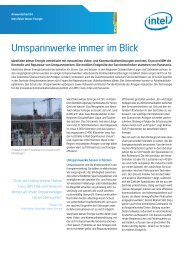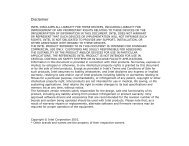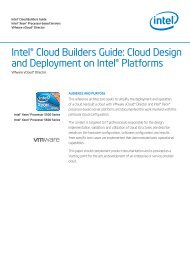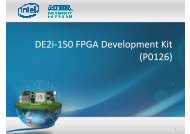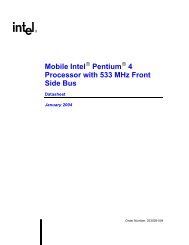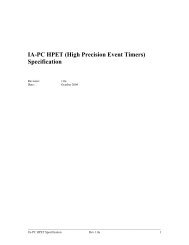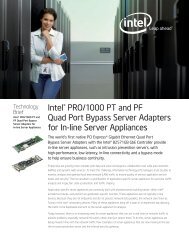Developing a Standard Enterprise Architecture Practice White ... - Intel
Developing a Standard Enterprise Architecture Practice White ... - Intel
Developing a Standard Enterprise Architecture Practice White ... - Intel
Create successful ePaper yourself
Turn your PDF publications into a flip-book with our unique Google optimized e-Paper software.
IT@<strong>Intel</strong> <strong>White</strong> Paper<strong>Developing</strong> a <strong>Standard</strong> <strong>Enterprise</strong> <strong>Architecture</strong> <strong>Practice</strong>Annual Maturity Evaluation Using the <strong>Enterprise</strong> <strong>Architecture</strong> Management (EAM) Assessmentfrom the IT Capability Management Framework (IT-CMF)<strong>Architecture</strong>Framework200820092010<strong>Architecture</strong>Processes<strong>Architecture</strong>Governance<strong>Architecture</strong>Value<strong>Architecture</strong>PlanningStrategicPlanningOrganizationStructure and SkillsCommunication andStakeholder Management<strong>Architecture</strong> Processes• Proliferation of a new version of the enterprise architecturetool set.• Inclusion of enterprise architects in several new key projects.<strong>Architecture</strong> Planning• Continued focus on separating Strategic <strong>Architecture</strong> fromProject <strong>Architecture</strong>.• Definition of unique enterprise architect roles focused onspecific business or technical areas.Strategic Planning• Continued use of the strategic frameworks to driveIT prioritization efforts.Organization Structure and Skills• Continued emphasis on enterprise architectureorganizational structure.• Increased opportunities for professional developmentincluding tools training, networking, mentoring, and the<strong>Enterprise</strong> <strong>Architecture</strong> Summit.Communication and Stakeholder Management• Stakeholder team more established and visible; increasedparticipation by stakeholder representatives.• Increased partnerships across organizations.• Increased communication through newsletter and blogging.Figure 3. <strong>Intel</strong> IT has seen continuous improvement in our enterprise architecture practice as the result of annual maturity assessments.RESULTS ANDCURRENT PROJECTSThe evolution of our enterprisearchitecture practice has resulted insignificant benefits to <strong>Intel</strong>. A standardarchitecture highlights substantialopportunities to reuse technology andprocesses across <strong>Intel</strong> IT, increasingproductivity.To encourage reuse, we initially tracked benefitsattributable to reuse across <strong>Intel</strong> IT. Forexample, we created the architecture for anauthentication mechanism that was thenreused across multiple projects. Since 2008,reuse has been considered an established partof IT culture, and we no longer need trackreuse in order to demonstrate the benefits.Examples of current architecture successesinclude service transformation architecture,IT consumerization, and enterprise customerinformation management.Service transformation architecture. <strong>Intel</strong>IT’s operations group is transforming the waywe provide services and support, using anapproach based on the Information TechnologyInfrastructure Library* (ITIL*) framework. Thisinvolves a shift away from supporting individualproducts to a strategy that delivers andsupports end-to-end services such as e-mail andconnectivity. This strategy is already achievingbenefits such as reductions in major incidentsand service calls. <strong>Enterprise</strong> architects helpedenable this transformation by mapping <strong>Intel</strong>business processes to IT services, acceleratingreuse of Solution <strong>Architecture</strong> across differentservice scenarios and helping to understandtotal cost of ownership. <strong>Architecture</strong> deliverablesincluded a new service interaction model thathelps <strong>Intel</strong> IT groups understand and defineservices, the dependencies between them, andthe value they provide to users.IT consumerization. An increasing number of<strong>Intel</strong>’s employees want to use their personallyowned handheld devices within the enterprise.This trend is known as IT consumerization.The number and variety of these devicesis increasing rapidly; today it includes smartphones, tablets, and personal PCs, and in thefuture will include new device categories thathave not yet emerged. <strong>Enterprise</strong> architectsworked with other <strong>Intel</strong> groups to create aReference <strong>Architecture</strong> that defines policyand the services we can support for devicesthat <strong>Intel</strong> IT does not manage. In 2010, <strong>Intel</strong> ITbegan letting employees use personal smartphones to access corporate e-mail and calendarservices. This initial groundwork helps <strong>Intel</strong>’sclient engineering teams more quickly supportnew devices, such as tablets, non-standard PCs,and a wider range of smart phones, as theybecome available.<strong>Enterprise</strong> customer informationmanagement. We defined a Strategic<strong>Architecture</strong> for customer informationmanagement that provides a vision for6 www.intel.com/IT



